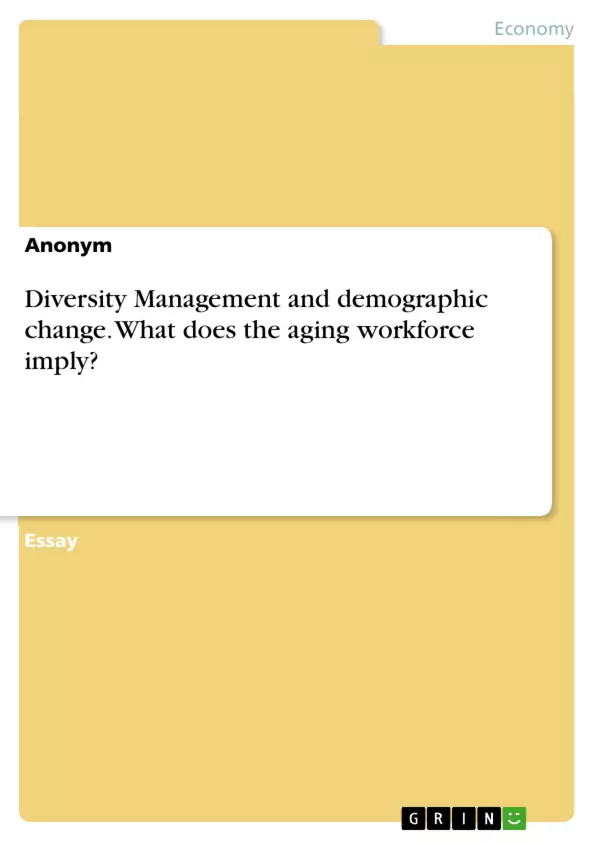This essay takes a closer look at diversity management with a focus on demographic change and an aging society. The author concentrates on changes and effects for companies.
Diversity Management and the demographic change are complex topics which can be considered and analyzed from several views, as they are treated differently from one continent, country, region or organization to another. Also, different perspectives, for instance of the organizational management, older and younger employees or government can be examined. This paper shall give an overview of older employees in organizations and what the aging workforce of an organization may imply.
Table of Contents
- Preface
- Diversity Management and demographic change - What does the aging workforce imply?
Objectives and Key Themes
This paper provides an overview of older employees in organizations and the implications of an aging workforce. It examines Diversity Management (DIM) in the context of demographic change, focusing on how organizations can adapt to an increasingly older workforce.
- Diversity Management in organizations
- The impact of demographic change on the workforce
- Strategies for managing an aging workforce
- The role of Corporate Health Management
- Adapting human resource management strategies
Chapter Summaries
Preface: This preface introduces the complexities of Diversity Management and demographic change, highlighting the varied perspectives across different contexts and the limitations imposed by word count restrictions. The paper focuses on older employees and their implications for organizational management.
Diversity Management and demographic change - What does the aging workforce imply?: This chapter delves into Diversity Management (DIM) as a crucial aspect of human resource management, emphasizing its growing importance due to globalization, migration, and other societal shifts. The chapter highlights the challenges organizations face in managing a diverse workforce, particularly the increasing age diversity due to demographic change, rising life expectancy, and declining birth rates. The text underscores the need for organizations to adapt their strategies to retain and utilize the skills and experience of older workers, referencing specific examples such as the 'Active@Work' project and the need for adjustments in human resource management strategies like recruiting, staffing, leadership development, and incentive programs. The chapter emphasizes the importance of maintaining employee health through Corporate Health Management and other initiatives such as flexible working models and individual career development plans to ensure the continued high contribution of older workers to organizational success. The impact of the 'baby boomer' generation on organizational dynamics is also discussed, highlighting the generational differences in values, skills, and expectations.
Keywords
Diversity Management, demographic change, aging workforce, Corporate Health Management, human resource management, generational differences, older workers, organizational adaptation, employee health, life expectancy, 'baby boomers'.
FAQ: Diversity Management and Demographic Change - What Does the Aging Workforce Imply?
What is the main topic of this paper?
This paper examines Diversity Management (DIM) in the context of demographic change, focusing on how organizations can adapt to an increasingly older workforce. It provides an overview of older employees in organizations and the implications of an aging workforce.
What are the key themes explored in the paper?
Key themes include Diversity Management in organizations, the impact of demographic change on the workforce, strategies for managing an aging workforce, the role of Corporate Health Management, and adapting human resource management strategies to accommodate an aging population.
What are the chapter summaries?
The preface introduces the complexities of Diversity Management and demographic change. The main chapter delves into Diversity Management (DIM) as a crucial aspect of human resource management, highlighting the challenges organizations face in managing a diverse workforce, particularly the increasing age diversity. It underscores the need for organizations to adapt their strategies to retain and utilize the skills and experience of older workers, referencing specific examples and emphasizing the importance of maintaining employee health through Corporate Health Management and other initiatives.
What are some specific strategies for managing an aging workforce mentioned in the paper?
The paper suggests adapting human resource management strategies such as recruiting, staffing, leadership development, and incentive programs. It also emphasizes the importance of flexible working models and individual career development plans to ensure the continued high contribution of older workers. The 'Active@Work' project is mentioned as an example.
What is the role of Corporate Health Management?
Corporate Health Management plays a crucial role in maintaining the health and well-being of older employees, enabling their continued contribution to organizational success.
How does the paper address generational differences?
The paper discusses the impact of the 'baby boomer' generation on organizational dynamics, highlighting the generational differences in values, skills, and expectations.
What are the key words associated with this paper?
Key words include: Diversity Management, demographic change, aging workforce, Corporate Health Management, human resource management, generational differences, older workers, organizational adaptation, employee health, life expectancy, and 'baby boomers'.
What is the overall objective of this paper?
The paper aims to provide an overview of the challenges and opportunities presented by an aging workforce and offer insights into effective strategies for managing diversity and adapting organizational practices to accommodate this demographic shift.
- Arbeit zitieren
- Anonym (Autor:in), 2017, Diversity Management and demographic change. What does the aging workforce imply?, München, GRIN Verlag, https://www.hausarbeiten.de/document/934289


